display RENAULT TWINGO RS 2009 2.G Engine And Peripherals Passenger Compartment Connection Unit OBD Workshop Manual
[x] Cancel search | Manufacturer: RENAULT, Model Year: 2009, Model line: TWINGO RS, Model: RENAULT TWINGO RS 2009 2.GPages: 179, PDF Size: 0.57 MB
Page 3 of 179

87B-3
MR-413-X44-87B000$048.mif
V5
UCH
Vdiag No.: 44PASSENGER COMPARTMENT CONNECTION UNIT
Fault finding - Introduction87B
Faults
Faults are declared as either present or stored (depending on whether they appeared in a certain context and have
disappeared since, or whether they remain present but have not been diagnosed within the current context).
The present or stored status of faults should be taken into consideration when the diagnostic tool is used following
the + after ignition supply being switched on (without operating the system components).
For a present fault, apply the procedure described in the Interpretation of faults section.
For a stored fault, note the faults displayed and apply the instructions in the Notes section.
If the fault is confirmed when the instructions in the Notes section are applied, the fault is present. Deal with the fault
If the fault is not confirmed, check:
–the electrical lines which correspond to the fault,
–the connectors for these lines (for oxidation, bent pins, etc.),
–the resistance of the component detected as faulty,
–the condition of the wires (melted or split insulation, wear).
Conformity check
The aim of the conformity check is to check data that does not produce a fault on the diagnostic tool because the
data is inconsistent. Therefore, this stage is used to:
–carry out fault finding on faults that do not have a fault display, and which may correspond to a customer
complaint.
–check that the system is operating correctly and that there is no risk of a fault recurring after repairs.
This section gives the fault finding procedures for statuses and parameters and the conditions for checking them.
If a status is not behaving normally or a parameter is outside the permitted tolerance values, consult the
corresponding fault finding page.
Customer complaints - Fault finding chart
If the test with the diagnostic tool is OK but the customer complaint is still present, the fault should be dealt with by
Customer complaints.
A summary of the overall procedure to follow is provided on the following page in the
form of a flow chart.
Page 9 of 179
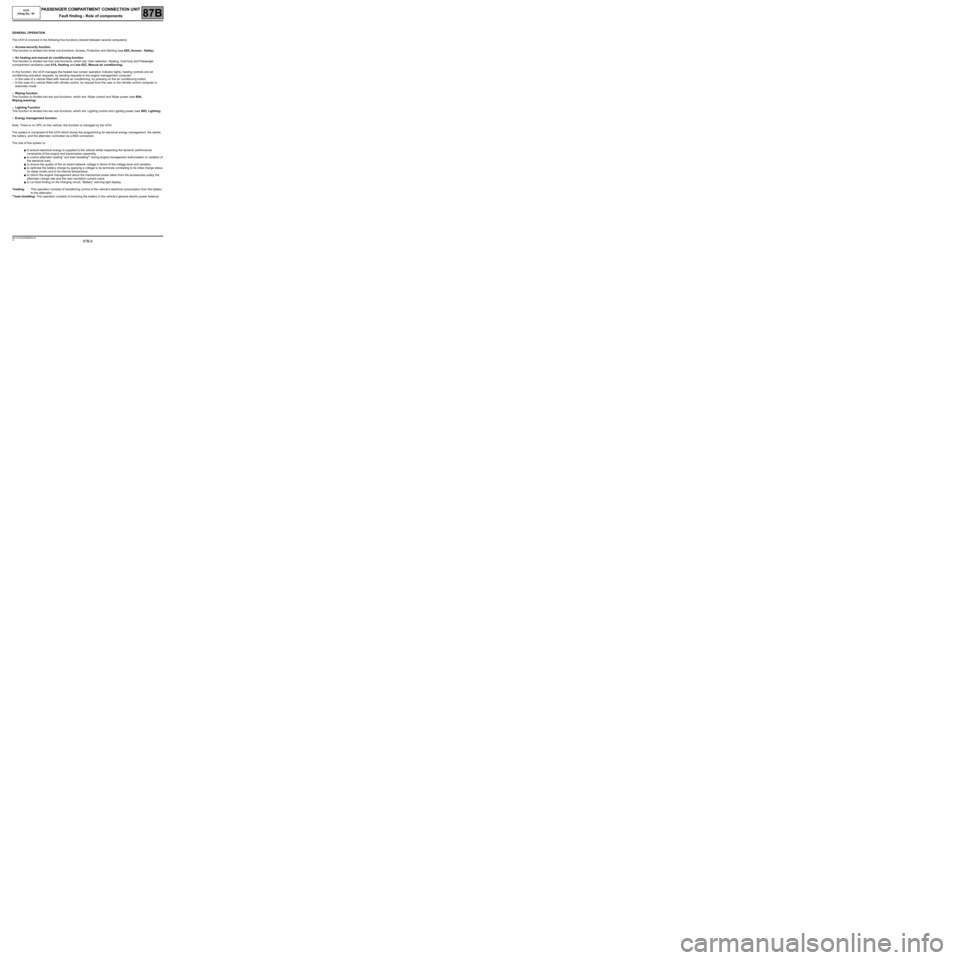
87B-9
MR-413-X44-87B000$192.mif
V5
87B
PASSENGER COMPARTMENT CONNECTION UNIT
Fault finding - Role of components
GENERAL OPERATION
The UCH is involved in the following five functions (shared between several computers):
–Access-security function
This function is divided into three sub-functions: Access, Protection and Starting (see 82D, Access - Safety).
–Air heating and manual air conditioning function
This function is divided into four sub-functions, which are: User selection, Heating, Cold loop and Passenger
compartment ventilation (see 61A, Heating and see 62C, Manual air conditioning).
In this function, the UCH manages the heated rear screen operation indicator lights, heating controls and air
conditioning activation requests, by sending requests to the engine management computer:
–In the case of a vehicle fitted with manual air conditioning, by pressing on the air conditioning button.
–In the case of a vehicle fitted with climate control, by request from the user or the climate control computer in
automatic mode.
–Wiping function
This function is divided into two sub-functions, which are: Wiper control and Wiper power (see 85A,
Wiping-washing).
–Lighting Function
This function is divided into two sub-functions, which are: Lighting control and Lighting power (see 80D, Lighting).
–Energy management function
Note: There is no UPC on this vehicle; this function is managed by the UCH.
The system is composed of the UCH which stores the programming for electrical energy management, the starter,
the battery, and the alternator controlled via a BSS connection.
The role of this system is:
●to ensure electrical energy is supplied to the vehicle whilst respecting the dynamic performance
constraints of the engine and transmission assembly,
●to control alternator loading* and load shedding** during engine management authorisation or variation of
the electrical load,
●to ensure the quality of the on board network voltage in terms of the voltage level and variation,
●to optimise the battery charge by applying a voltage to its terminals correlating to its initial charge status
(in sleep mode) and to its internal temperature,
●to inform the engine management about the mechanical power taken from the accessories pulley, the
alternator charge rate and the rotor excitation current value,
●to run fault finding on the charging circuit: “Battery” warning light display.
*loading: This operation consists of transferring control of the vehicle's electrical consumption from the battery
to the alternator.
**load shedding: This operation consists of involving the battery in the vehicle's general electric power balance.
MR-413-X44-87B000$192.mif
UCH
Vdiag No.: 44
Page 10 of 179

87B-10
MR-413-X44-87B000$192.mif
V5
UCH
Vdiag No.: 44PASSENGER COMPARTMENT CONNECTION UNIT
Fault finding - Role of components87B
–Energy management function
Role of BSS connection:
This bidirectional connection located between the UCH and the alternator circulates the following signals:
–Signals sent by the alternator: rotor current value, alternator charge value and electrical, thermal and
mechanical fault statuses.
–Signals sent by the UCH to the alternator: voltage setpoint, rail setpoint and rail inhibition.
Role of the DF terminal:
The signal circulating in the DF terminal is the alternator charge signal (displayed using PR073 "Alternator
charge signal") which is used to adapt the alternator supply to the demands of the electrical consumers
(such as the passenger compartment heating resistors, heated rear screen, etc.).
Depending on the battery charge status, the operating phase and the battery temperature, the UCH determines what
the voltage across the battery terminals should be.
When the battery charge drops, and PR076 Battery voltage after rest decreases, the UCH can temporarily
increase PR075 Alternator setpoint voltage by 1 V for a period of 15 minutes after switching on + after ignition
feed.
Before and during starting, PR075 Alternator setpoint voltage is fixed at 10.7 V.
A maximum of 30 seconds after the engine has started, the UCH sets PR075 Alternator setpoint voltage to the
optimum value calculated.
The injection computer can also control the alternator regulation voltage. The injection computer sends the
maximum authorised power delivered by the engine, to the UCH via the multiplex network. If this power supplied by
the engine is less than the power consumed by the alternator, the UCH reduces the PR075 Alternator setpoint
voltage.
The battery warning light will flash if a low battery charge is detected (no-load voltage less than 12.2 V: voltage
measured during technical use) for the first 12 miles (20 kms), then the warning light stops flashing. Also, the magic
eye of the battery (the hydrometer) is black.
–Access - Security function (see 82D, Access - Security, Role of components).
–Heating and manual air conditioning function (see 61A, Heating, Role of components and 62C, Manual air
conditioning, Role of components).
–Wiping function (see 85A, Washing wiping, Role of components).
–Lighting function (see 80D, Lighting, Role of components). Note:
At the time of user activation, if the mileage is less than 12 miles (20 kms) the charge status is used to display a
warning: this ensures that vehicles are delivered with correct batteries.
Page 13 of 179
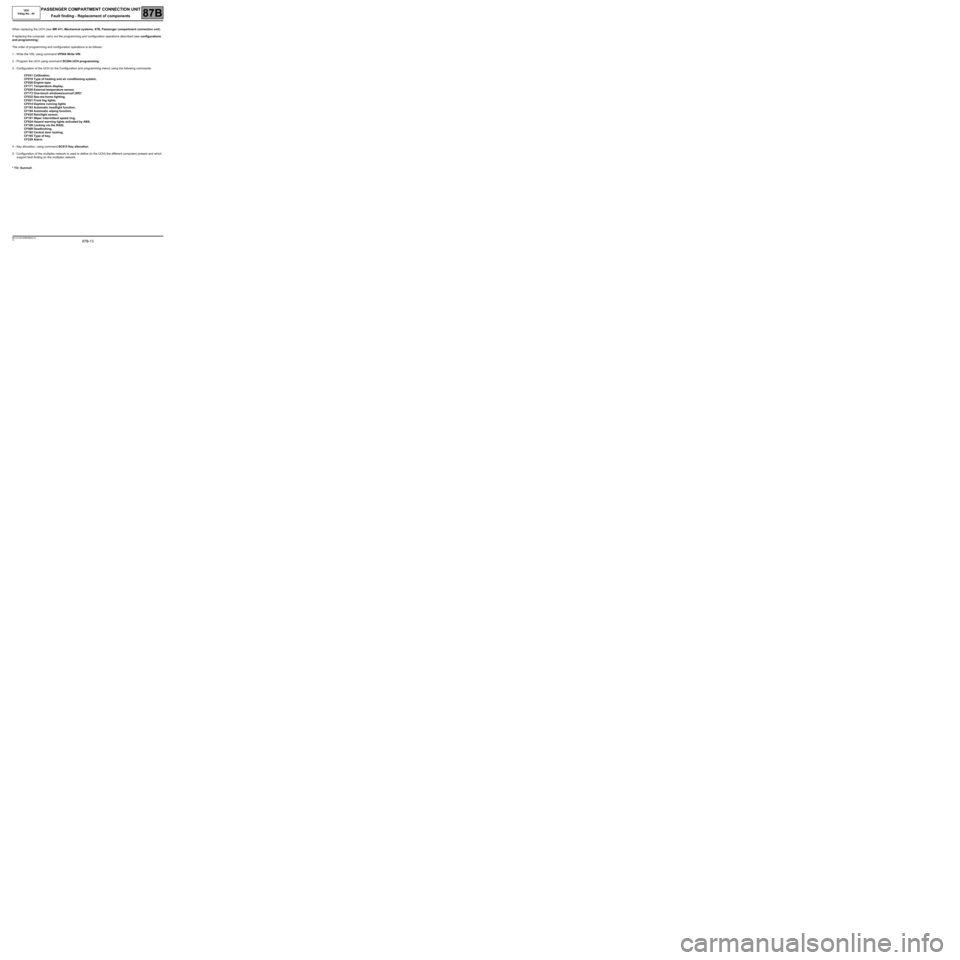
87B-13
MR-413-X44-87B000$240.mif
V5
87B
PASSENGER COMPARTMENT CONNECTION UNIT
Fault finding - Replacement of components
When replacing the UCH (see MR 411, Mechanical systems, 87B, Passenger compartment connection unit).
If replacing the computer, carry out the programming and configuration operations described (see configurations
and programming).
The order of programming and configuration operations is as follows:
1 - Write the VIN, using command VP004 Write VIN.
2 - Program the UCH using command SC004 UCH programming.
3 - Configuration of the UCH (in the Configuration and programming menu) using the following commands:
CF031 Calibration,
CF019 Type of heating and air conditioning system,
CF028 Engine type,
CF171 Temperature display,
CF029 External temperature sensor,
CF173 One-touch windows/sunroof (SR)*.
CF032 See-me-home lighting,
CF021 Front fog lights,
CF014 Daytime running lights
CF193 Automatic headlight function,
CF194 Automatic wiping function,
CF035 Rain/light sensor,
CF191 Wiper intermittent speed ring,
CF024 Hazard warning lights activated by ABS,
CF108 Locking via the RAID,
CF009 Deadlocking,
CF192 Central door locking,
CF195 Type of key,
CF229 Alarm.
4 - Key allocation, using command SC015 Key allocation.
5 - Configuration of the multiplex network is used to define (in the UCH) the different computers present and which
support fault finding on the multiplex network.
* TO: Sunroof.
MR-413-X44-87B000$240.mif
UCH
Vdiag No.: 44
Page 14 of 179
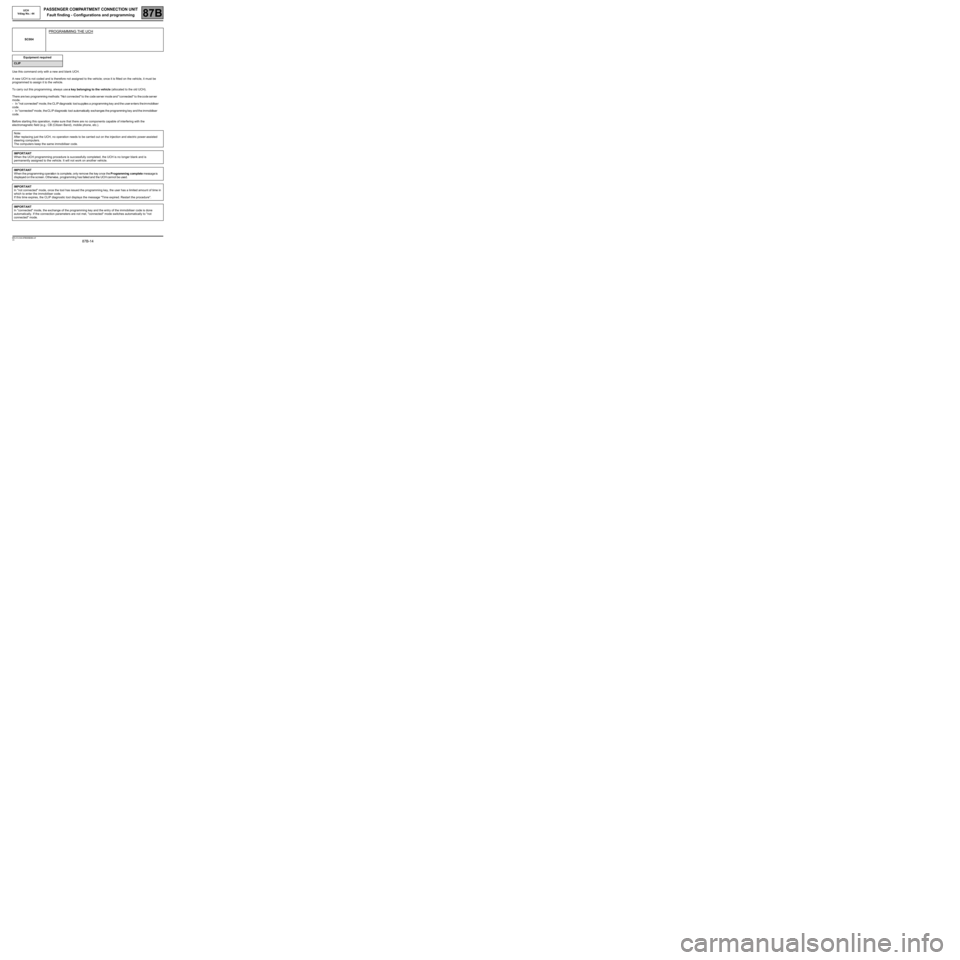
87B-14
MR-413-X44-87B000$288.mif
V5
87B
PASSENGER COMPARTMENT CONNECTION UNIT
Fault finding - Configurations and programming
Use this command only with a new and blank UCH.
A new UCH is not coded and is therefore not assigned to the vehicle; once it is fitted on the vehicle, it must be
programmed to assign it to the vehicle.
To carry out this programming, always use a key belonging to the vehicle (allocated to the old UCH).
Thereare two programming methods: "Not connected" to the code server mode and "connected" to the code server
mode.
-In"not connected" mode, the CLIP diagnostic tool supplies a programming key and the user enters the im mobiliser
code.
-In"connected" mode, the CLIP diagnostic tool automatically exchanges the programming key and the immobiliser
code.
Before starting this operation, make sure that there are no components capable of interfering with the
electromagnetic field (e.g.: CB (Citizen Band), mobile phone, etc.).SC004
PROGRAMMING THE UCH
Equipment required
CLIP
Note:
After replacing just the UCH, no operation needs to be carried out on the injection and electric power-assisted
steering computers.
The computers keep the same immobiliser code.
IMPORTANT
When the UCH programming procedure is successfully completed, the UCH is no longer blank and is
permanently assigned to the vehicle. It will not work on another vehicle.
IMPORTANT
When the programming operation is complete, only remove the key once theProgrammingcompletemessage is
displayed on the screen. Otherwise, programming has failed and the UCH cannot be used.
IMPORTANT
In "not connected" mode, once the tool has issued the programming key, the user has a limited amount of time in
which to enter the immobiliser code.
If this time expires, the CLIP diagnostic tool displays the message "Time expired. Restart the procedure''.
IMPORTANT
In "connected" mode, the exchange of the programming key and the entry of the immobiliser code is done
automatically. If the connection parameters are not met, "connected" mode switches automatically to "not
connected" mode.
MR-413-X44-87B000$288.mif
UCH
Vdiag No.: 44
Page 15 of 179
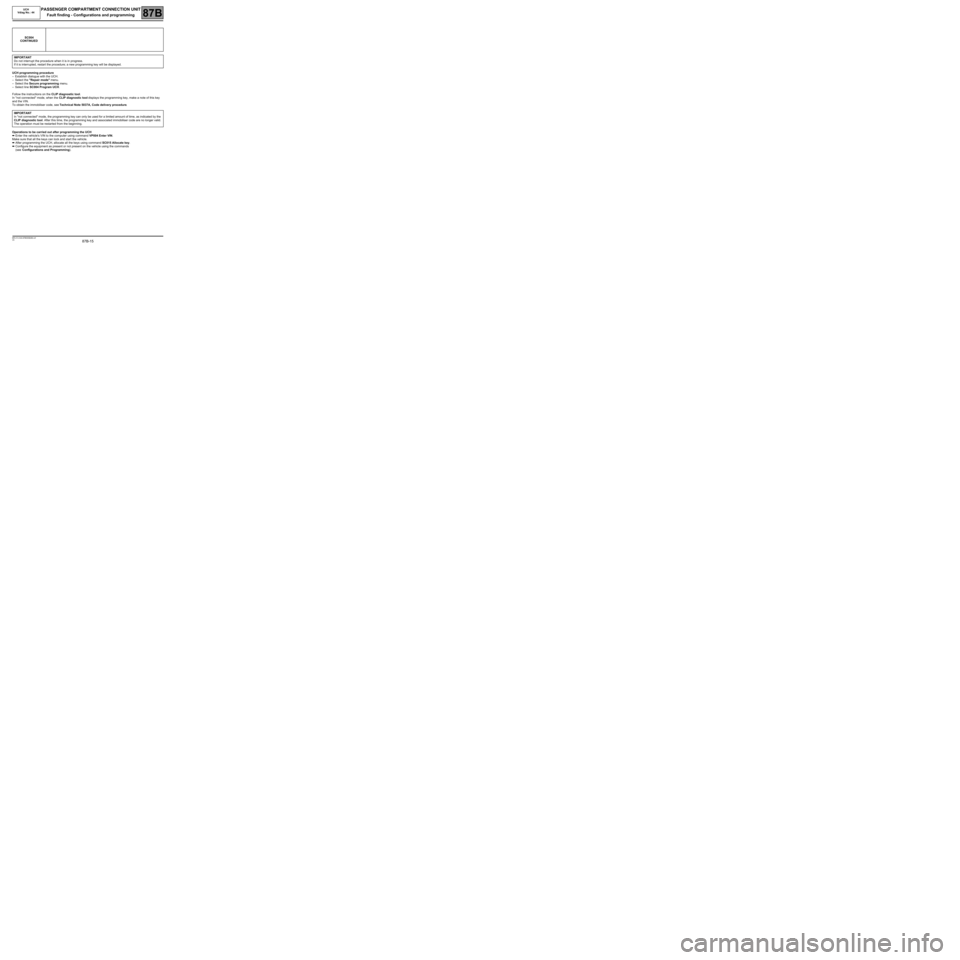
87B-15
MR-413-X44-87B000$288.mif
V5
UCH
Vdiag No.: 44PASSENGER COMPARTMENT CONNECTION UNIT
Fault finding - Configurations and programming87B
UCH programming procedure
–Establish dialogue with the UCH.
–Select the "Repair mode" menu.
–Select the Secure programming menu.
–Select line SC004 Program UCH.
Follow the instructions on the CLIP diagnostic tool.
In "not connected" mode, when the CLIP diagnostic tool displays the programming key, make a note of this key
and the VIN.
To obtain the immobiliser code, see Technical Note 5037A, Code delivery procedure.
Operations to be carried out after programming the UCH
➡ Enter the vehicle's VIN to the computer using command VP004 Enter VIN.
Make sure that all the keys can lock and start the vehicle.
➡ After programming the UCH, allocate all the keys using command SC015 Allocate key.
➡ Configure the equipment as present or not present on the vehicle using the commands
(see Configurations and Programming). SC004
CONTINUED
IMPORTANT
Do not interrupt the procedure when it is in progress.
If it is interrupted, restart the procedure; a new programming key will be displayed.
IMPORTANT
In "not connected" mode, the programming key can only be used for a limited amount of time, as indicated by the
CLIP diagnostic tool. After this time, the programming key and associated immobiliser code are no longer valid.
The operation must be restarted from the beginning.
Page 16 of 179
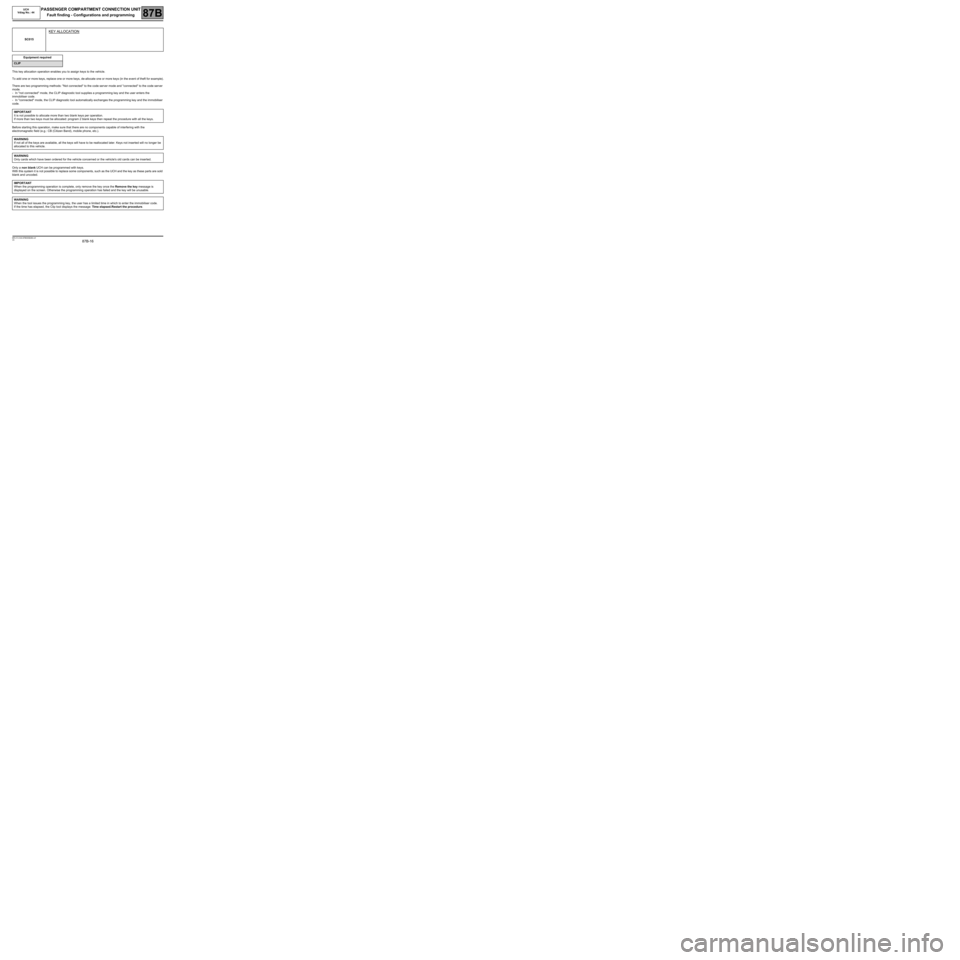
87B-16
MR-413-X44-87B000$288.mif
V5
UCH
Vdiag No.: 44PASSENGER COMPARTMENT CONNECTION UNIT
Fault finding - Configurations and programming87B
This key allocation operation enables you to assign keys to the vehicle.
To add one or more keys, replace one or more keys, de-allocate one or more keys (in the event of theft for example).
There are two programming methods: "Not connected" to the code server mode and "connected" to the code server
mode.
-In "not connected" mode, the CLIP diagnostic tool supplies a programming key and the user enters the
immobiliser code.
-In "connected" mode, the CLIP diagnostic tool automatically exchanges the programming key and the immobiliser
code.
Before starting this operation, make sure that there are no components capable of interfering with the
electromagnetic field (e.g.: CB (Citizen Band), mobile phone, etc.).
Only a non blank UCH can be programmed with keys.
With this system it is not possible to replace some components, such as the UCH and the key as these parts are sold
blank and uncoded.SC015
KEY ALLOCATION
Equipment required
CLIP
IMPORTANT
It is not possible to allocate more than two blank keys per operation.
If more than two keys must be allocated: program 2 blank keys then repeat the procedure with all the keys.
WARNING
If not all of the keys are available, all the keys will have to be reallocated later. Keys not inserted will no longer be
allocated to this vehicle.
WARNING
Only cards which have been ordered for the vehicle concerned or the vehicle's old cards can be inserted.
IMPORTANT
When the programming operation is complete, only remove the key once the Remove the key message is
displayed on the screen. Otherwise the programming operation has failed and the key will be unusable.
WARNING
When the tool issues the programming key, the user has a limited time in which to enter the immobiliser code.
If the time has elapsed, the Clip tool displays the message: Time elapsed.Restart the procedure.
Page 17 of 179
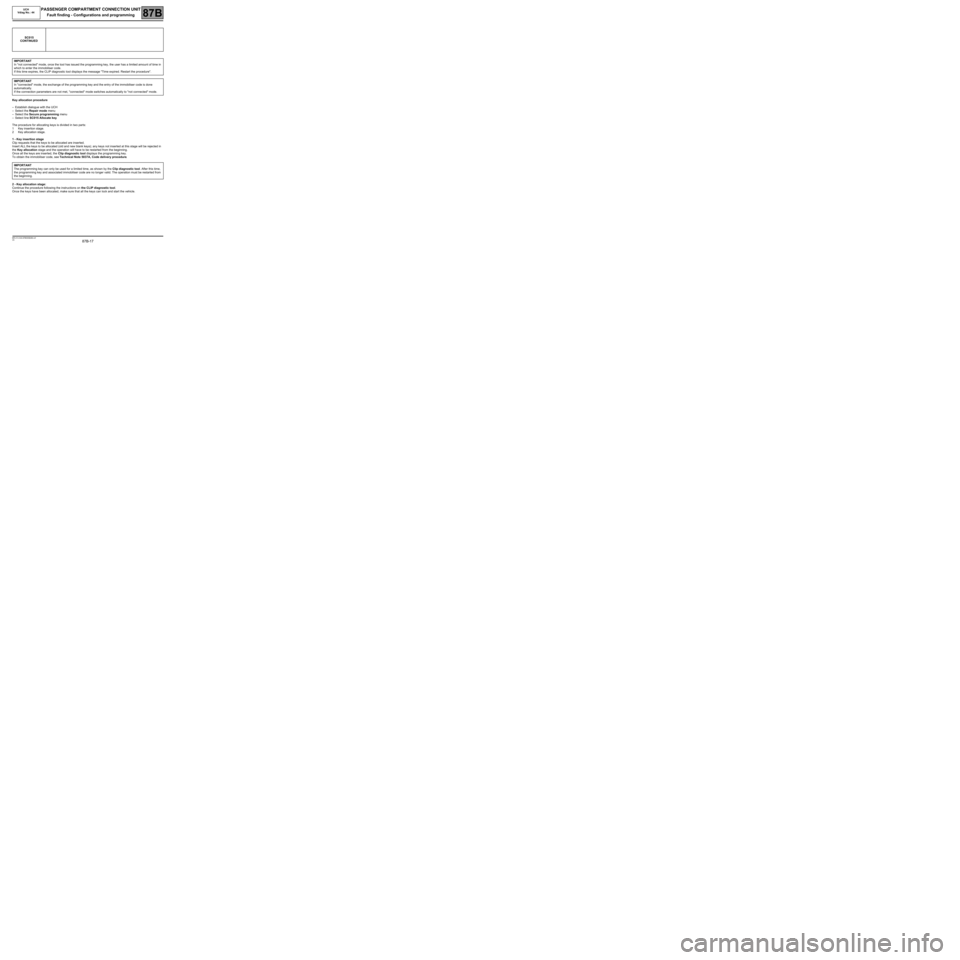
87B-17
MR-413-X44-87B000$288.mif
V5
UCH
Vdiag No.: 44PASSENGER COMPARTMENT CONNECTION UNIT
Fault finding - Configurations and programming87B
Key allocation procedure
–Establish dialogue with the UCH
–Select the Repair mode menu
–Select the Secure programming menu
–Select line SC015 Allocate key.
The procedure for allocating keys is divided in two parts:
1Key insertion stage.
2Key allocation stage.
1 - Key insertion stage
Clip requests that the keys to be allocated are inserted.
Insert ALL the keys to be allocated (old and new blank keys); any keys not inserted at this stage will be rejected in
the Key allocation stage and the operation will have to be restarted from the beginning.
Once all the keys are inserted, the Clip diagnostic tool displays the programming key.
To obtain the immobiliser code, see Technical Note 5037A, Code delivery procedure.
2 - Key allocation stage:
Continue the procedure following the instructions on the CLIP diagnostic tool.
Once the keys have been allocated, make sure that all the keys can lock and start the vehicle.SC015
CONTINUED
IMPORTANT
In "not connected" mode, once the tool has issued the programming key, the user has a limited amount of time in
which to enter the immobiliser code.
If this time expires, the CLIP diagnostic tool displays the message "Time expired. Restart the procedure''.
IMPORTANT
In "connected" mode, the exchange of the programming key and the entry of the immobiliser code is done
automatically.
If the connection parameters are not met, "connected" mode switches automatically to "not connected" mode.
IMPORTANT
The programming key can only be used for a limited time, as shown by the Clip diagnostic tool. After this time,
the programming key and associated immobiliser code are no longer valid. The operation must be restarted from
the beginning.
Page 18 of 179
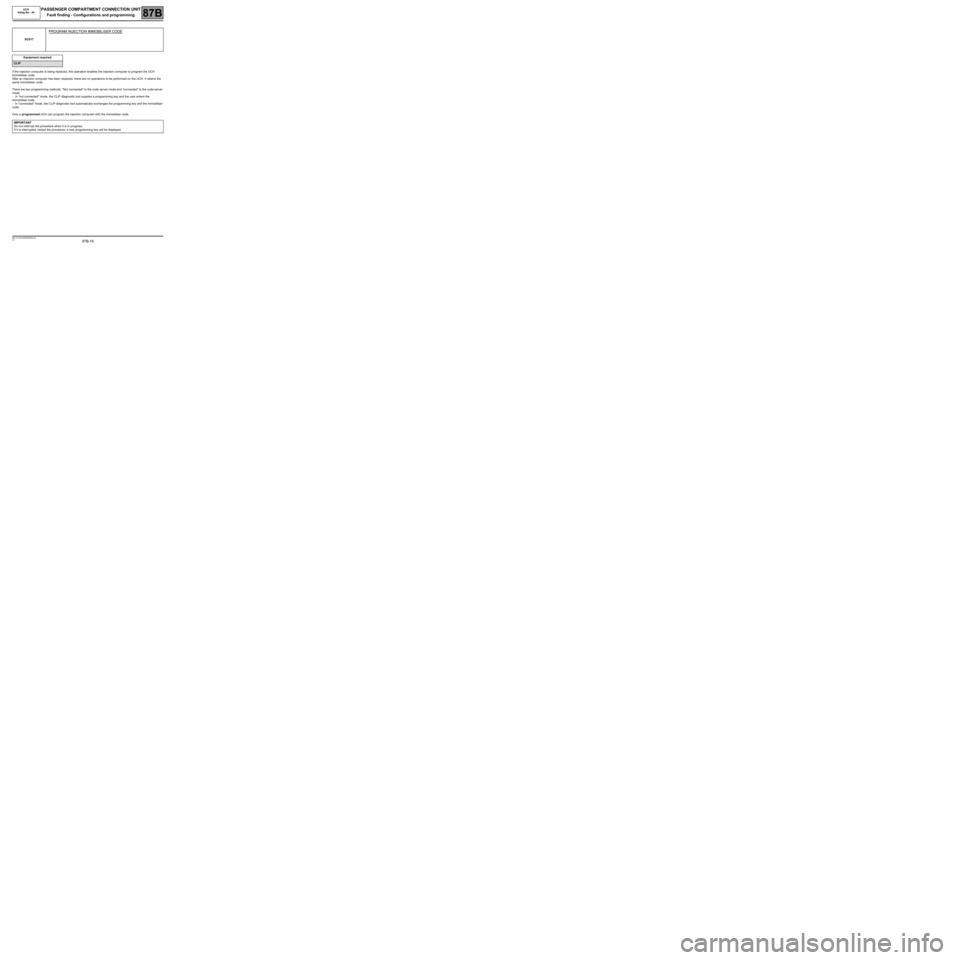
87B-18
MR-413-X44-87B000$288.mif
V5
UCH
Vdiag No.: 44PASSENGER COMPARTMENT CONNECTION UNIT
Fault finding - Configurations and programming87B
If the injection computer is being replaced, this operation enables the injection computer to program the UCH
immobiliser code.
After an injection computer has been replaced, there are no operations to be performed on the UCH. It retains the
same immobiliser code.
There are two programming methods: "Not connected" to the code server mode and "connected" to the code server
mode.
-In "not connected" mode, the CLIP diagnostic tool supplies a programming key and the user enters the
immobiliser code.
-In "connected" mode, the CLIP diagnostic tool automatically exchanges the programming key and the immobiliser
code.
Only a programmed UCH can program the injection computer with the immobiliser code. SC017
PROGRAM INJECTION IMMOBILISER CODE
Equipment required
CLIP
IMPORTANT
Do not interrupt the procedure when it is in progress.
If it is interrupted, restart the procedure; a new programming key will be displayed.
Page 19 of 179
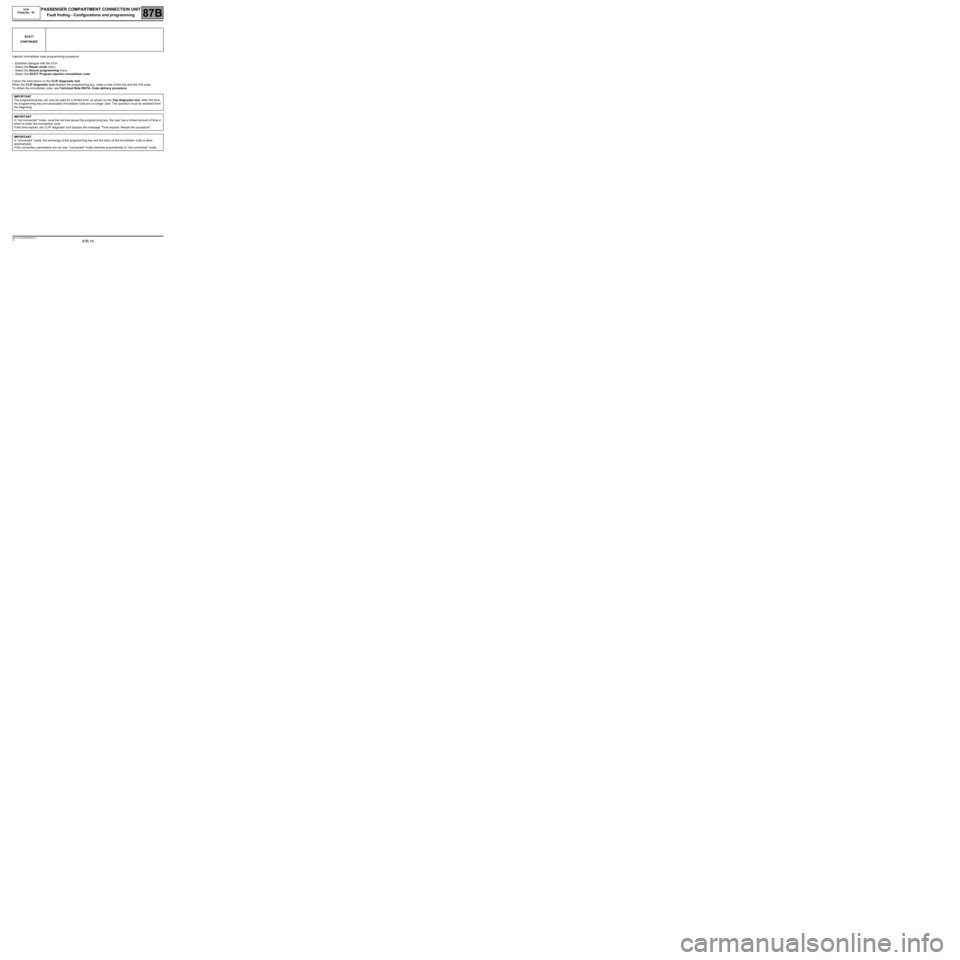
87B-19
MR-413-X44-87B000$288.mif
V5
UCH
Vdiag No.: 44PASSENGER COMPARTMENT CONNECTION UNIT
Fault finding - Configurations and programming87B
Injection immobiliser code programming procedure:
–Establish dialogue with the UCH
–Select the Repair mode menu
–Select the Secure programming menu
–Select line SC017 Program injection immobiliser code.
Follow the instructions on the CLIP diagnostic tool.
When the CLIP diagnostic tool displays the programming key, make a note of this key and the VIN code.
To obtain the immobiliser code, see Technical Note 5037A, Code delivery procedure. SC017
CONTINUED
IMPORTANT
The programming key can only be used for a limited time, as shown by the Clip diagnostic tool. After this time,
the programming key and associated immobiliser code are no longer valid. The operation must be restarted from
the beginning.
IMPORTANT
In "not connected" mode, once the tool has issued the programming key, the user has a limited amount of time in
which to enter the immobiliser code.
If this time expires, the CLIP diagnostic tool displays the message "Time expired. Restart the procedure''.
IMPORTANT
In "connected" mode, the exchange of the programming key and the entry of the immobiliser code is done
automatically.
If the connection parameters are not met, "connected" mode switches automatically to "not connected" mode.